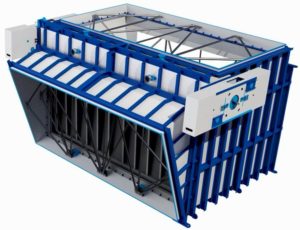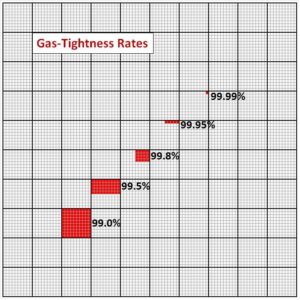A “penny wise, pound foolish” approach is costly in the long run
Coal-fired power plant duct systems are designed so that emissions control systems, such as precipitators, desulphurization systems, fans, and selective catalytic reduction systems can be inspected and maintained while the main process remains online. Essential to achieving this is the installation of effective, safe, reliable and easy-to-operate isolation equipment at the auxiliaries’ inlets and outlets.
The long-term effectiveness of isolation equipment – dampers — is a prime consideration for the end-user. The damper leakage rate is a critical focal point, both in terms of operating efficiency and personnel safety.
The degree of isolation required depends upon the damper’s primary function in a system. If the function does not require 100% isolation, then various types of dampers could be used to provide sealing efficiencies ranging from 99.00% to 99.99%.
Isolation of flue gas can be accomplished utilizing a guillotine, louver, or diverter/flap damper, and the different damper types provide different leak-proof capabilities.
Choosing the wrong type of damper for isolation can be problematic or even catastrophic. Even a small amount of leakage can have serious implications.
If the damper must isolate a portion of the system for occasional maintenance, the damper must provide 100% isolation in order to be considered “man-safe.”
Consider this: Although 99% sealing efficiency may seem like a very high value, a 1% leakage area in a typical duct could represent a hole large enough to get a person’s head and shoulders through. Just a 1% leakage area would actually allow leakage of 3-10% of the full load flow — the flow through the full-open damper at the Full Load rating of the device being isolated or controlled. (Under typical plant conditions, a damper is considered to have “low” leakage if leakage is less than 2% of its wide-open  flow.)
flow.)
Sealing performance is the key criterion in a specification for isolating equipment. A critical side effect of the concept of sealing efficiency is the assessment of the method by which a vendor achieves, and guarantees, 100% isolation. All dampers leak to some extent, and anyone who states otherwise is not being truthful.
For a damper to be considered a “zero-leak” device it requires an air-purge system. A clean air barrier is introduced between the tandem sealing elements at a pressure greater than the greatest differential on either side of the blade, preventing cross-blade leakage of untreated gas and simultaneously ventilating the isolated area.
All too often, a vendor will use a large volume of seal air to hide the shortcomings of the basic sealing system. Large seal air fans are sometimes fitted in duplicate. This, however, does not factor that the most probable reason for fan failure is a loss of power, whereupon, neither fan will run. Thus, the seals must be capable of providing, over an extended period, a high sealing efficiency without external assistance so that maintenance personnel can be sure of leaving an isolated section safely in the event of an emergency.
A heinous error when purchasing isolation equipment is to set aside the superior design of an experienced supplier on the grounds of capital cost alone.
Decades worth of evidence make it abundantly clear that well-functioning isolation equipment cannot be bought for “bargain basement” prices, and the long-term implications of buying inferior equipment is always far more expensive and riskier than buying the right equipment from the start.
Before any price comparisons are made, the evaluating engineer must be satisfied that the equipment meets the end user’s needs and can actually achieve the guarantees claimed. He should assess the claims made on the basis of the information provided and his, and other users’, experience.
To determine true operational value and safety, equipment evaluation must be on the basis of sound engineering principles, not just on initial cost.
Contact:
Mark Martel
Business Manager
